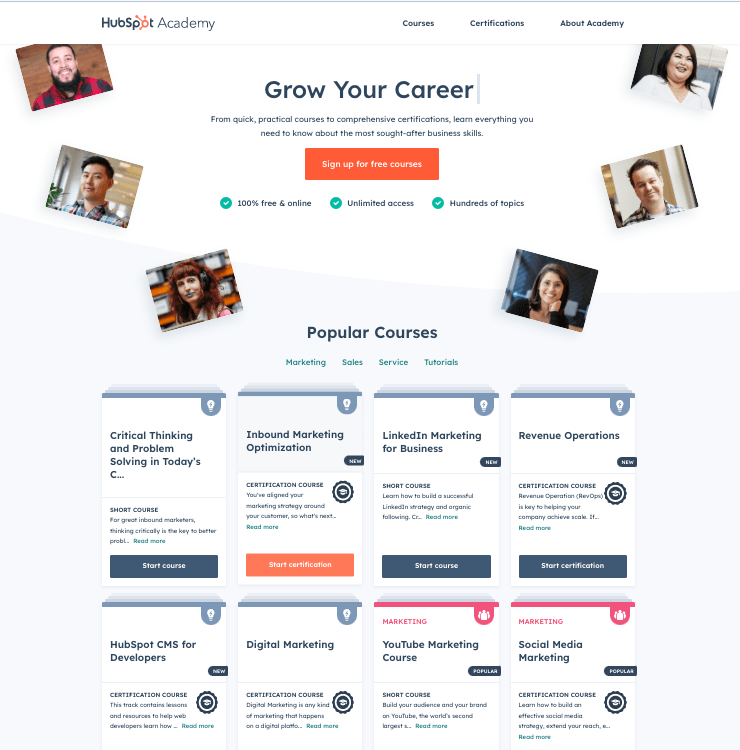8 Steps to Launching an Online Learning Academy Your Customers Will Love
73% of people say customer experience impacts their purchasing decisions.
Which means, nowadays, companies are looking for fresh ways to keep their customers happy.
Many companies are doing this by launching customer education programs and online learning academies that give their customers access to resources, blog posts, webinars, knowledge centers, and certification courses that help them learn about their product, troubleshoot problems, and ultimately realize product value.
The HubSpot Academy is an excellent example of this. Launched in 2012 as a way to help its customers learn and apply new marketing skills to grow their business, The HubSpot Academy has evolved into the go-to destination for hundreds of thousands of people looking to improve their skills related to inbound marketing, sales, and customer service/support.
Among other things, a strong learning academy can help you provide helpful resources to your customers, increase customer retention, engage with new prospects, and build domain authority.
From the outside looking in, creating an online learning academy on this scale may seem intimidating, if not impossible. But launching one isn’t as out of reach as you might think. Let’s walk through the necessary steps to launch an online learning academy your customers will love.
How to Launch a Successful Online Academy in 8 Steps
1. Set a specific goal.
When you’re starting your online-learning journey, it can be easy to get lost in the possibilities.
For instance, maybe you want to help your Customer Success (CS) team speed up onboarding.
You also want to reduce the number of support tickets and issues for your Customer Services team. And you want to increase product adoption for your Product team.
And you want to boost lifetime value (LTV) for your Leadership team.
All of these outcomes are possible with an online learning academy, but at this point in your journey, pick one.
To help you decide, identify your ideal learner persona and their biggest challenge. Ask yourself:
- Are you struggling to get them using a new feature?
- Does engagement decline after onboarding?
- Are your Customer Success Managers (CSMs) overwhelmed by support tickets and requests?
Figure out what’s pressing right now and start there.
Then, solve that challenge, prove the value to internal stakeholders, especially your leadership team, and start solving more company and customer challenges.
2. Build your team.
One could argue that building a team should come before you set your goals, or at least in tandem with it, but for the sake of this article, I put it here — look at goal setting and team building as steps 1a and 1b.
Just like you don’t want to spread your resources too thin by setting too many goals at the beginning, don’t bring too many cooks into the kitchen.
Instead, have one person lead the charge who’s passionate about online learning and aligned with your goal.
Building Your Team
- Subject Matter Expert (SME): The SME understands your customers, their challenges and what they’ll need from the content to realize product value.
- Instructional Designer (ID): The ID is someone who has design expertise and training in developing content to achieve specific learning outcomes.
- Technical Expert: The technical expert ensures that the learning management system (LMS) or other learning technology works properly, including integrations and data collection. They can also lead the changeover from legacy learning technology.
- Executive Sponsor: An executive sponsor ensures you have a line of sight into the boardroom and maintain alignment. An executive sponsor is a “must-have” for even the newest teams.
In a perfect world, you’d build a cross-functional team that has all of these roles filled.
In reality, that’s probably not going to happen at this point.
So, if you’re embarking on this adventure, know that you don’t need a formal team to get started. You only need someone passionate about learning, some content, and customers excited to learn.
3. Consider an LMS.
Most, if not all, established online learning academies ride on the back of an LMS due to their ability to help teams create, manage, deliver, track and optimize content at scale.
Consider this scenario: You’re using blog posts, videos, quizzes and certifications to train 150 customers — but you’re not using an LMS.
In turn, CSMs, Support, and Service teams pull the necessary levers manually to keep customers happy and realizing value. For instance, they might need to send onboarding documentation when a new customer signs the dotted line.
For newer companies dipping their toes into online learning, these teams might be able to keep pace with this demand without sacrificing the white-glove service customers demand.
That said, as the product evolves, and the customer base grows, content creation accelerates and customer demands will intensify, making it harder for your team’s to keep up manually.
An LMS automates these tedious and time-consuming tasks and ensures you’re providing the best learning experience without drowning your Service and Support teams.
With an always-on learning academy, you also allow your customers to learn whenever and wherever they want. Not only does this make sense for a remote world, but it reduces the strain on your teams by giving customers the chance to solve their own problems without submitting a ticket or emailing their CSM.
Pro Tip: When you’re looking for an LMS, prioritize mobile-friendliness and cloud-based software. With a mobile LMS, you can deliver flexible and accessible learning to the devices your customers actively use. A cloud-based LMS allows you to scale and localize content without disrupting the learning experience.
4. Create content.
When you’re just getting into online learning and ready to start creating content, you’ll fall into one of two groups:
- Group #1: You have content (a lot or a little)
- Group #2: You don’t have content
If you’re in the first group, major props — your launch date just got closer. The only step you’ll want to take now is to make sure the content aligns with your persona and achieves the right outcome (e.g., helps your customers activate their account or use an advanced feature).
If you’re in the second group, I still give you props — you just have a little more work to do. Luckily, content creation isn’t as complex or laborious as you’d think.
If starting from scratch, be strategic and ask yourself what you absolutely need to get your minimum viable product (MVP) off the ground.
Then, outline that content, including the description, objectives, titles, and content types. From there, work with your team to create content or a course (whatever you have the time for).
Pro Tip: If you’re struggling to create content due to a lack of resources, see if other teams have some. For example, the Marketing team might have an overview deck. Similarly, your Support team might have a document of common challenges.
As you’re creating content, keep scale in mind. You’ll want to consider:
- How will you create content to speak to different cultures and languages as you grow?
- What happens when you grow your team and more people are involved in content creation?
- How will you know what to update and when?
- How will you create content to meet different learning styles?
The sooner you answer these questions, the better. While it may seem fruitless to address them now given the scope of your online learning academy, a time will come when you’re ready to scale.
By thinking about scale now, you’ll be able to grow without disrupting the learning experience for your customers.

5. Put everything under a microscope.
Before you launch, examine all parts of your online learning academy, from your processes, team and the LMS (if you’re using one).
- Content: Does your content do its job and lead to the intended learning outcomes?
- Team: Is your team ready to go? Does everyone understand their roles and responsibilities? Do they have a good understanding of the academy’s goal and what they have to do to ensure your customers succeed?
- LMS: Is the data you’ll need to prove ROI flowing between systems? How about the integrations, like one with your CRM? Are automated emails going out as intended? You should also have your technical expert look at the backend of the LMS. First impressions matter, so ensure everything is working and primed to deliver a seamless learning experience.
You can take it one step further by asking a small group of customers to go through the process. Then, take their feedback and make adjustments before launching to everyone.
Finally, before you officially launch, communicate with the rest of the company, especially the leadership team, and let them know what you’re doing.
While your success ultimately hinges on your customers buying into online learning, company-wide support will go a long way, too.
6. Let it fly.
It’s time to launch.
Remember: This is the beginning of your journey — think of this as V1 or your MVP. Your learning academy will evolve, but your focus now needs to be on getting your customers engaged.
Then, once you start tracking performance and sourcing feedback, you can iterate (step #7).
Pro Tip: This version of your online learning academy will almost certainly lack some features and capabilities you’ve been thinking about from the start. That’s great. Keep this “wishlist” in your back pocket and cross features and capabilities off as you grow and the resources become available.
7. Shout it from the mountain tops.
In tandem with your launch — if not leading up to it — hit up Slack, email, the breakroom, Zoom or any other way you connect with people and let them know what you’re doing.
Do this from two angles:
- Internal: Tell as many people and teams as possible about your academy and how it can help them. For example, show the Support team how it can help reduce support tickets. Tell your Sales team how it can help them close deals faster. Your goal is to get people excited and show them how the academy helps them look like rockstars. The more buy-in you have from people inside your company, the easier it’ll be to maintain buy-in and budget.
- External: Let your customers know what’s coming. Show them why you’ve launched your academy and how it’ll help them. Then, show them how to navigate it, access content and reach out for additional support. Your goal is to get them inside and engaged; you want to start creating a sticky environment they’ll rely on far into the future.
As you go, keep the communication going by celebrating wins, sharing resources on new features, and more to keep your company and customers engaged.
Online learning is a marathon, not a sprint. If people peter out after a few weeks, the time you spent up until now will be largely for naught.
8. Make it even better.
I said it once, but it begs repeating: The online learning academy you launch is not in its final form.
As everyone gets used to online learning, start sourcing feedback to get a clear vantage point into how things are going.
Is your team operating smoothly?
Is your content effective?
Are videos the right length?
Do your quizzes miss the mark because they require customers to answer short-form questions?
Are certain content formats working better than others?
Is the LMS working properly?
As you gather these insights, make improvements to enhance the learning experience and ensure you’re still delivering an experience that delights — and helps retains — your customers.
Launch an Online Learning Academy Your Customers Will Love
Don’t let a lack of bandwidth, resources or experience stop you from launching an online learning academy — launching one your customers will love is only 8 steps away.
In 2022 and beyond, these 8 steps are some of the most important ones you can make.
Your customers (and your bottom line) will thank you.
![]()



